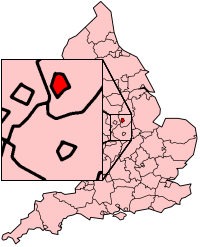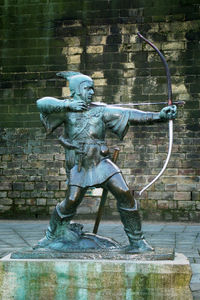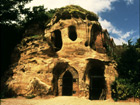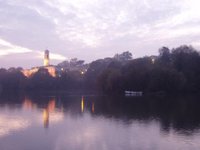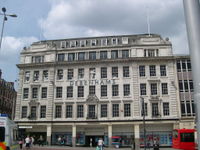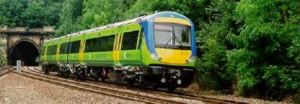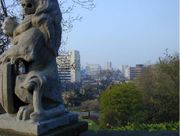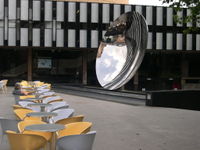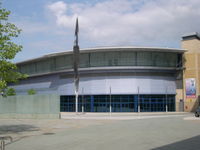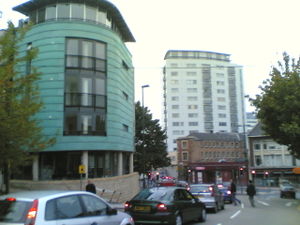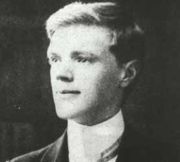Nottingham
2007 Schools Wikipedia Selection. Related subjects: Geography of Great Britain
Nottingham is a city (and county town of Nottinghamshire) in the East Midlands of England. The centre of Nottingham lies on the River Leen and its southern boundary follows the course of the River Trent, which flows from Stoke to the Humber. According to the 2001 census, Nottingham has an estimated city population of 275,100 which increased to an estimated 278,700 in 2005, while the Nottingham Urban Area conurbation (which includes surrounding suburbs outside the city boundary, and neighbouring towns) has a population of 666,358 ( ). Nottingham is a member of the English Core Cities Group.
The heart of Nottingham City Centre is the Old Market Square, which is undergoing a major redevelopment during 2006. Most of the main shopping streets surround the square. The Council House, whose disproportionately tall dome can be seen for miles around, is at the top of the square. The inside of the Council House is the Exchange Arcade, a shopping centre. A bohemian quarter of the city known as Hockley has arisen in recent years, situated close to the Lace Market area. Nottingham receives a lot of tourism, mostly because of the legend of Robin Hood, visiting Sherwood forest and Nottingham Castle.
History
The first evidence of settlement dates from pre-Roman times, and it is clear that the Romans also lived in the area.
An early name for Nottingham was "Tigguo Cobauc" which means "a place of cavy dwellings." Founded by Anglo-Saxon invaders after 600 AD, parts of the settlement have included man-made caves, dug into soft sandstone. The Saxons were led by a chieftain named Snot . Snot brought together his people in an area where the historic Lace Market in the City can now be found. The place was called "Snotingaham" —literally, "the home of Snot's people" (Inga = the people of; Ham = home). As with many place names throughout England, the word has since been modified, to "Nottingham".
Nottingham was later captured by the Danes (Vikings) and in the 9th century became one of the five boroughs (fortified towns) of the Danelaw.
In the 11th century, Nottingham Castle was constructed on a sandstone outcrop by the River Trent. The Anglo-Saxon settlement on the hill now occupied by the Lace Market around St. Mary's Church developed into the English Borough of Nottingham and housed its Town Hall and Courts. A settlement also developed around the castle on the hill opposite and was the French borough supporting the Normans in the Castle. Eventually, the space between was built on as the town grew and the Market Square became the focus of Nottingham several centuries later.
The town became a county corporate in 1449, giving it effective self-government, in the words of the charter, "for eternity".
The legend of Robin Hood first arose in the Middle Ages. Robin Hood is said to have lived in Sherwood Forest, to the north of the town, with the Sheriff of Nottingham as his greatest enemy. The current Sheriff of Nottingham, Matthew Keyworth, is a largely ceremonious figure with no real jurisdiction. While the legends are almost certainly untrue, particularly in their details, they have had a major impact on Nottingham, with Robin Hood imagery a popular choice for local businesses and many modern tourist attractions exploiting the legend. The Robin Hood Statue in Nottingham is within walking distance from the Old Market Square.
No fewer than three pubs in Nottingham claim the title of England's Oldest Pub. The contenders for the crown are Ye Olde Trip To Jerusalem near the castle, The Bell on the Old Market Square, and The Salutation on Maid Marian Way. Ye Olde Trip To Jerusalem is supposedly named for its role as a major meeting point for those going on the Crusades in the Middle Ages. However, its claim may be due partly to the questionable date of 1189 painted on the side of the inn. A recent television documentary tested the three claimants and found that, while each has its own evidence, none can claim exclusivity. The Trip, while the oldest building and oldest location, was for most of its early life a brewery and not a public house. The Salutation sits on the oldest recognised public house site, but the current building is comparatively recent. The Bell, although not in such an antiquated location, does boast the oldest public house building. There is also conflicting information available: dendrochronology dating evidence from roof timbers in the Salutation give a date for the building of c. 1420 with similar dates for the Bell. Ultimately, the roots of the multiple claims can be traced to various subtleties of definition in terms such as "public house" and "inn".
Nottingham was one of the boroughs reformed by the Municipal Corporations Act 1835, and at that time consisted of the parishes of Nottingham St Mary, Nottingham St Nicholas and Nottingham St Peter. It was expanded in 1877 by adding the parishes of Basford, Brewhouse Yard, Bulwell, Radford, Sneinton, Standard Hill and parts of the parishes of West Bridgford, Carlton, Wilford ( North Wilford). In 1889 Nottingham became a county borough under the Local Government Act 1888. Nottingham was extended in 1933 by adding Bilborough and Wollaton, parts of the parishes of Bestwood Park and Colwick, and a recently developed part of the Beeston urban district. A further boundary extension was granted in 1951 when Clifton and Wilford (south of the River Trent) were incorporated into the city.
Caves of Nottingham
The Nottingham cave network was substantially expanded and became home to a large proportion of the poorer populace, particularly those involved in the tanning industry. The caves were gradually abandoned in the 19th and early part of the 20th century, but came into use again as air raid shelters during World War II. A section of the cave network under the Broadmarsh shopping centre is now open as a tourist attraction, and some parts are still used as pub cellars.
Another section of the caves, under the castle, is still in regular use as the indoor rifle range of Nottingham Rifle Club. In addition, Ye Olde Trip to Jerusalem Inn, a pub that claims to be the oldest in Britain (see above), is partly built into the cave system below the castle. Although the pub's building only dates from the 16th or 17th century, the caves themselves may date to the 11th century and could have been the site of the brewhouse for the castle.
St. Anne's Well, or Robin Hood's Well
St. Anne's Well/Robin Hood's Well is a historic well linked to the legend of Robin Hood which is located around two miles north-east of Nottingham. Public knowledge of this well dates back to at least 1287. It was originally called the "Owswell", but by 1500 it was usually called, "Robin Hood's Well", due to a reputed brawl that occurred on the site involving Robin Hood and his men. By 1800, the water from the well was said to have healing powers:
- The water is very old. It will kill a toad. It is used by those who are afflicted with rheumatic pains.
During the 1800s the area was the site of a rowdy public house (until numerous complaints forced its closure) before becoming a tea room. When part of a railway line was extended over the site in 1887, all of the buildings occupying the site were demolished. In 1987, the well was discovered in the car park of a public house in Wells Road. Action is now being undertaken by some in an attempt to restore this historically important site.
There is a drawing by local artist Thomas Cooper Moore (1827 - 1901) of St. Anne's Well and its associated buildings circa 1856.
Architectural & Historical Contexts
Nottingham is relatively unusual among big manufacturing cities in Britain in having a medieval and pre-industrial past of equal importance to its more recent one. Unfortunately, this is not readily apparent from the city’s buildings. Nottingham Castle, founded by William the Conqueror, famed through the Middle Ages as one of the country’s finest strongholds, and where Charles I raised the Royal Standard in 1642 no longer exists, and has been replaced by a classical ducal palace. Of the medieval castle only the (restored) gatehouse, and the ruined remains of some walls/foundations, survive. Further to the east, Old Market Square, focal point of the city, and reputedly the largest open square of any English city is being redeveloped.
The city descends from north to south, and eventually to the River Trent, though the river itself is not a central feature. The western third of the city houses the castle and several new tall buildings along with some harmonious streets around the Playhouse mainly occupied by professional firms, and the unimposing Nottingham Cathedral (Roman Catholic). The central third leads down from the Nottingham Trent University building past the Theatre Royal to Old Market Square, which has the Council House to the east. This was built in the 1920s to display civic pride, ostentatiously utilising Baroque columns and statues of two lions; the Exchange Arcade underneath, containing boutique shops, is a small but pleasant covered area. Streets lead south to the Broad Marsh Shopping Centre, a bus terminus. The Canalside, further south of this, and adjacent to the railway station and several new but sympathetically designed modern offices, is an inviting redevelopment with bars and restaurants. The eastern third of the city contains the Victoria Shopping Centre and the Victoria centre flats (1972), at 75m high, the highest building in the city. Interesting areas of this part of the city are Hockley Village (see below) and the Lace Market, where the old red-brick warehouses have been utilised for other purposes, creating an attractive aspect to this part of the city. The Parish Church of St Mary the Virgin is in this area: it and the adjacent Shire Hall are two of the more interesting buildings from the city’s pre-industrial past.
Probably the most interesting and attractive building (though not really within the city centre but within city limits) is Wollaton Hall, about 4km to the west of the centre, just north of Nottingham University campus.
Geography
Nottingham is located at (52.9667,-1.1667) 1.
The City of Nottingham boundaries are tightly drawn and exclude several suburbs and towns that are usually considered part of Greater Nottingham, including Arnold, Carlton, West Bridgford, Beeston and Stapleford. Outlying towns and villages include Hucknall, Eastwood, Tollerton, Ruddington, Ilkeston and Long Eaton of which the last two are in Derbyshire. The geographical area of Greater Nottingham includes several local authorities: Gedling, Broxtowe, Rushcliffe, Ashfield, Erewash and Amber Valley.
Education
Nottingham is home to two universities: the University of Nottingham and Nottingham Trent University including over 40,000 full-time students. The University of Nottingham's teaching hospital, Queen's Medical Centre, is the largest hospital in the UK. Nottingham Trent University is one of the country's new generation of trade schools.
Other notable educational institutions include the further education college New College Nottingham, Confetti Institute of Creative Technologies, Nottingham High School, Bilborough College, Nottingham High School for Girls, Chilwell School - a specialist in maths, media arts and computing, The Nottingham Bluecoat School and Technology College, South Nottingham College and Djanogly City Academy and Greenwood Dale Technology College. Nottingham is home and headquarters of the National College for School Leadership.
The Nottingham School of Fashion is a fashion school respected around the country and produced the designer Paul Smith.
Industry
Nottingham is home to the headquarters of many well known companies. One of the best known is Boots the Chemists, founded in the city by John Boot in 1849 and substantially expanded by his son Jesse Boot (Lord Trent).
Other large current employers include the credit reference agency Experian, the energy company Powergen, the tobacco company John Player & Sons betting company Gala Group, Siemens, Speedo, high street opticians Vision Express, games and publishing company Games Workshop and the American Credit card company Capital One, whose European offices are situated by the side of Nottingham station. Nottingham is also the home of the Inland Revenue and the DSA.
Although Boots itself is no longer a direct player in the pharmaceutical industry, a combination of former Boots researchers and university spin-off companies have spawned a thriving pharmaceutical/science/biotechnology sector. BioCity, the UK’s biggest bioscience innovation and incubation centre, sits in the heart of the city and houses around thirty science-based companies. Other notable companies in the sector include ClinPhone and Pharmaceutical Profiles. The city has recently been made one of the UK's six Science Cities.
Until recently bicycle manufacturing was a major industry, the city being the birthplace of Raleigh Cycles in 1886 and later joined by Sturmey-Archer, the creator of 3-speed hub gears. However, Raleigh's factory on Triumph Road, famous as the location for the filming of Saturday Night and Sunday Morning, was demolished in Summer 2003 to make way for the University of Nottingham's expansion of Jubilee Campus.
Nottingham is also joint headquarters of Paul Smith, the high fashion house.
The schools and aerial photographers, H Tempest Ltd were Nottingham based for many years, until relocating to St Ives (Cornwall) around 1960. A skeleton office remained for many years in the original building next to Mundella School.
Many of the UKs railway ticket machines and platform departure boards run software written by Atos Origin in their offices in Nottingham. Other major industries in the city include engineering, textiles, knitwear and electronics. Nottingham is gradually increasing the number of software developers in the city, Free Radical, Serif, Reuters are all based in the city.
Nottingham is progressively changing from an industrial city to one based largely in the service sector. Tourism—particularly from the United States and the Far East—is becoming an increasingly significant part of the local economy.
Economy
This is a chart of trend of regional gross value added of Nottingham at current basic prices published (pp.240-253) by Office for National Statistics with figures in millions of British Pounds Sterling.
| Year | Regional Gross Value Added | Agriculture | Industry | Services |
|---|---|---|---|---|
| 1995 | 4,149 | 2 | 1,292 | 2,855 |
| 2000 | 5,048 | 1 | 912 | 4,135 |
| 2003 | 5,796 | - | 967 | 4,828 |
Shopping
Nottingham is positioned 3rd in the shopping league in England, behind Birmingham and London but ahead of Manchester and Leeds. The approved £400 million Broadmarsh Shopping Centre redevelopment could change this all, moving Nottingham back to its 2nd spot in the retail area.
There are two main shopping centres in Nottingham: Victoria Centre and Broadmarsh with smaller centres being the The Exchange Arcade and the Flying Horse Walk (the latter once a famous hotel). The Bridlesmith Gate area has extensive designer shops, and is also the home of the original Paul Smith boutique. There are also various side streets and alleys that hide some interesting and often overlooked buildings and shops such as Poultry Walk, West end Arcade, Hurts Yard and others, with many specialist shops.
Many department stores also operate in Nottingham. It includes names such as House of Fraser, John Lewis, Debenhams, and Marks & Spencer. John Lewis was until recently called Jessops, even though owned by John Lewis since 1933. It changed its name in 2002 after a refurbishment. Hockley Village caters to alternative tastes with shops like Ice Nine and Void, famous across the city. The Broadmarsh Shopping Centre is set to be redeveloped to a greater standard in the near future.
Transport
Nottingham is close to the M1 motorway and is also well-served by train services operated by Midland Mainline from Nottingham station to London.
Nottingham East Midlands Airport, served by low-cost international airlines, makes the city easily accessible from other parts of the world providing daily services to many principal European destinations such as Paris, Frankfurt, Berlin, and Amsterdam, internal flights to Edinburgh and Belfast and limited services to trans-continental destinations such as Barbados, Mexico, Sanford and Florida. Nearby Robin Hood Airport Doncaster Sheffield also provides domestic European and Trans-Atlantic services. Birmingham International airport is about one hour's drive away, providing flights to most principal European cities, New York, Boston, Toronto, Montreal, Dubai and the Indian Sub-Continent.
Nottingham is bucking the national trend, as in the city bus use is growing while employment rates are rising . This is a result of the city council, as well as the two principal operators, Nottingham City Transport (NCT) and Trent Barton, making multi-million-pound investments in some of the newest fleets in the country. NCT was also the first transport operator in the UK to use RFID technology for its EasyRider bus passes, introduced in 2000. The two operators are also frequent winners of the National Bus Operator of the Year award.
The re-opening of the Robin Hood Line to passengers rather than just freight, between 1993 and 1998 linked Nottingham with its close neighbours of Hucknall, Kirkby-in-Ashfield, Sutton-in-Ashfield and Mansfield. Other lines connect the city to Beeston, Burton Joyce, Netherfield and Carlton. Nottingham has direct services to Birmingham, Manchester, Sheffield, Liverpool and Norwich.
Nottingham Express Transit a light rail system opened in 2004, running from Hucknall in the north to the city's railway station. An additional spur to/from Phoenix Park serves as a Park and Ride Station close to the M1 motorway (Junction 26). Phase 2 development of the system will add 2 new lines will to the southern and western suburbs to create a 3 line network.
Crime
The City of Nottingham is widely reported to be one of the most crime hit areas of England, and many crimes show statistics that are several times higher than the English average. A nationwide survey in 2006 said that Nottingham topped the crime rankings for police statistics on murders, burglaries, and vehicle crime, and "had almost five times the level of crime as the safest town in the rankings". The survey was initially condemned as inaccurate by Nottingham City Council and Nottinghamshire police force due largely to the use of out of date (2001) population figures, although a revised survey based on 2004 population estimates backed up the original rankings. While the crime figures in the city are high, initiatives introduced to tackle the levels of crime appear to be having an effect, with a 2006 Home Office survey showing that the overall level of crime in the city is down by 12% since 2003.
Culture
Nottingham has two main theatres, the Nottingham Playhouse and the Theatre Royal (which also houses the Royal Concert Hall) and a third worthy of attention at University of Nottingham's Lakeside Art Centre. There are also several art galleries which often receive national attention, particularly the Nottingham Castle Museum, the Angel Row gallery (attached to the main library) alongside the university Djanogly Gallery and Wollaton Park's Yard Gallery. Both of the city's universities also put on a wide range of theatre, music and art events open to the public throughout the year.
The city has several multiplex cinemas alongside two arts cinemas. The independent cinemas are the Screen Room, which claims to be the world’s smallest cinema (at just 21 seats) and the Broadway Cinema, which comes highly recommended by Quentin Tarantino who held the British premiere of Reservoir Dogs here.
There is a classical music scene with long established groups such as the city's Symphony Orchestra, Philharmonic Orchestra, Harmonic Society, Bach Choir, Early Music Group Musica Donum Dei and the Symphonic Wind Orchestra giving regular performances in the city.
The annual Goose Fair in October is always popular being one of the largest fairs in the country. More generally the city is regarded as having a diverse nightlife with many clubs and bars in the centre of town that are popular amongst both the local and student communities.
Nottingham won the Britain in Bloom competition, in the Large City category, in 1997, 2001 and 2003. It also won the Entente Florale Gold Award in 1998.
Nottingham is known for its large teenage alternative scene ( Rock, punk, emo etc.), the heartland of which is Old Market Square which is currently being redeveloped, to their dismay. Another major hotspot is Rock City. The Sumac Centre based in Forest Fields has for many years supported local upcoming musicians, artists and film makers. It also supports a variety of campaign groups.
Tourism
Popular tourist attractions in Nottingham include Nottingham Castle, City of Caves, The Galleries of Justice, and The Tales of Robin Hood on Maid Marian Way, as well as the City's ancient pubs. There are a number of parks and gardens around Nottingham that are popular among tourists and residents. These include Wollaton Park (over 500 acres) near to the University Highland Park on the Nottingham University campus, Colwick Park, which includes the racecourse, and the Nottingham Arboretum, Forest Recreation Ground and Victoria Park which are both in or close to the city centre. Sherwood Forest, Rufford Country Park, Creswell Crags and Clumber Park are further away from the city itself. A new park is being developed in the city at the Eastside City development.
Entertainment
The 2,500-capacity Nottingham Royal Concert Hall and 9,500-capacity Nottingham Arena attract the biggest names in pop, rock and R&B. For less mainstream acts and a generally more intimate atmosphere, Nottingham boasts a selection of great smaller venues including Junktion 7, The Old Angel, the award-winning dedicated rock music venue Rock City and Rock City's cozy sister venues The Rescue Rooms, The Social and Stealth, amongst others. In total these venues, their packed listings and close proximity arguably make Nottingham the capital of live music in the UK.
Nottingham has a great reputation for a lively pub and club scene.
In the 1980s, Nottingham was barely mentioned in the Good Food Guide; but now there are several restaurant entries and a range of cuisine reflecting the ethnic diversity of the city. The Nottingham Restaurant Awards play a leading role in promoting the industry.
The large number of students in the city bolsters the nighttime entertainment scene. There are several well established areas of the city centre for entertainment such as Lace Market, Hockley, The Waterfront and The Corner House.
Sport
Nottingham is home to two football teams: Nottingham Forest (currently in the Football League One) (who under their most famous manager, the late Brian Clough, won the European Cup twice in succession) and Notts County (who play in Football League Two). The latter are the oldest Football League team in the UK, and indeed the world, having been founded in 1862 (a year before the establishment of the Football Association).
Trent Bridge cricket ground, located across the river in West Bridgford, Rushcliffe, is the home of Nottinghamshire County Cricket Club, who were winners of the 2005 County Championship and runners-up in the 2006 Twenty20 cup competition. Trent Bridge is a major venue for international Test matches, and also hosts other important cricketing events such as the Twenty20 cup Finals and regular One-Day International games. The ground, which has won architectural awards for the design of some of its newer stands, also houses a cricket academy, a hotel, and a gym, and also uniquely features not one, but two public houses built within the ground itself.
All three famous sports venues are within sight of each other even though the River Trent separates Trent Bridge and Forest's stadium (known as the City Ground and next to the cricket ground) from Notts County's ground, Meadow Lane . As a curiousity Meadow Lane is actually in the City of Nottingham and the City Ground is in the County of Nottingham the river forming the boundary. Forest should not be confused with The Forest which is an (open) green space where Goose Fair (see above) is held; however, the team take their name from this open space, having been founded there in 1865. This makes Forest the third oldest team in the league.
The National Ice Centre, a large ice skating rink; the city's links to ice skating can be traced back to arguably its most famous children of recent times, Olympic ice dancing champions Jayne Torvill and Christopher Dean who collected a unanimous 6.0 score at the 1984 Winter Olympics at Sarajevo. The NIC is used as a training and competition venue for speed skating, sledge hockey and figure skating and receives an annual grant from bodies such as Sport England to maintain and fund these sports.
The NIC is the home of the Nottingham Panthers ice hockey club, founded in 1946 and currently one of the biggest and best supported clubs in the United Kingdom. There is a thriving junior ice hockey programme which is also based at the centre. Since 2001, Nottingham has been the host city of the annual ice hockey Play-Off Championship Finals weekend, which attracts fans from many different parts of the country.
The city's rugby union side, Nottingham R.F.C. are currently based in Beeston but are currently preparing a new venue in West Bridgford.
There is a large tennis centre, where the annual Samsung Open is held in the weeks immediately prior to Wimbledon and has been used as warm-up practice by various tennis stars.
The National Water Sports Centre is based at Holme Pierrepont, with a 2000m regatta lake for rowing, canoeing and sailing, and a white water slalom course fed from the river. A number of other sailing, rowing and canoeing clubs are also based along the River Trent, as is the boatbuilder Raymond Sims.
Every Year since 1981 Nottingham has played host to the 'Robin Hood Marathon' taking in many of the city's historic and scenic sights. The race is ran alongside a Half Marathon and a Fun Run among other events and is widely considered to be the second best Marathon in the UK.
Religion
In Nottingham one can find places of worship for all the major world religions, including Christianity, Islam, Hinduism, Sikhism and Taoism. The Synagogue on Shakespeare Street is particularly well appointed.
Nottingham is generally regarded as a cathedral city, with Roman Catholic Cathedral of St. Barnabas on Derby Road. Designed by the architect Augustus Welby Northmore Pugin, was consecrated in 1844 it is the cathedral church for the Roman Catholic Diocese of Nottingham which covers Derbyshire, Leicestershire, Nottinghamshire and Lincolnshire.
Nottingham's Anglicans are in the Diocese of Southwell and Nottingham, based at Southwell Minster in Southwell. Nottingham has three historic parish churches all of which date back to medieval times. St. Mary the Virgin, in the Lace Market is the oldest foundation (dating from the eighth or ninth centuries) but the building is at least the third on the site dating from 1377 to 1485. St. Mary's is considered the mother church of the City and Civic Services are held here, including the welcome to the new Lord Mayor of Nottingham each year. St. Peter's in the heart of the city is the oldest building in continuous use in Nottingham with traces of building starting in 1180. St. Nicholas' was rebuilt after destruction in the Civil War.
Non-conformism was strong from the seventeenth century onwards and a variety of chapels and meeting rooms proliferated throughout the town. Sadly many of these grand buildings have been demolished, including Halifax Place Chapel, but some have been re-used, notably the Unitarian Chapel on High Pavement which is now a public house.
William Booth, the founder of the Salvation Army, was born in Nottingham in 1829.
Dwellings within and around Nottingham
| Districts within Nottinghamshire | |
|---|---|
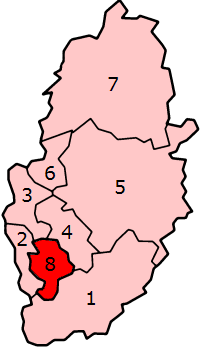 |
|
| 1 | Rushcliffe |
| 2 | Broxtowe |
| 3 | Ashfield |
| 4 | Gedling |
| 5 | Newark and Sherwood |
| 6 | Mansfield |
| 7 | Bassetlaw |
| 8 | Nottingham |
Within the City of Nottingham
|
|
Around the City of Nottingham
|
|
Twin Cities
 - Ghent, Belgium
- Ghent, Belgium - Harare, Zimbabwe
- Harare, Zimbabwe - Karlsruhe, Germany
- Karlsruhe, Germany - Ljubljana, Slovenia
- Ljubljana, Slovenia - Minsk, Belarus
- Minsk, Belarus - Ningbo, China
- Ningbo, China
Famous People from Nottingham
Famous people born in or near Nottingham include (sorted by DOB):
- ( c1550) William Lee, inventor of the stocking frame
- (1763) George Africanus Famous Nottingham entrepreneur
- (1793) George Green (of Green's Mill), mathematician and physicist, famed for Green's theorem
- (1829) William Booth, founder of The Salvation Army
- (1850) Jesse Boot, who nationalised Boots the Chemists, which was founded by his father, (1815) John Boot
- (1935) Stella Rimington, the first female head of MI5, educated at Nottingham High School for Girls
- (1946) Harold Shipman, the serial killer
- (1947) Paul Smith, fashion designer
Authors and poets
- (1785) Henry Kirke White poet
- (1788) The poet Lord Byron resided at Newstead Abbey and is buried at nearby Hucknall along with his mathematical daughter (1815) Ada Lovelace
- (1885) D. H. Lawrence, internationally famous author, born in Eastwood and educated at Nottingham High School
- (1928) Alan Sillitoe, an Angry Young Author
- (1957) Robert Harris (novelist), author of Fatherland [1992], Enigma [1995], Archangel [1998], Pompeii [2003] and Imperium [2006]
Musicians
- (1940) John Crocker clarinet and saxophone with Chris Barber's Jazz Band until 2003
- (1944) Alvin Lee guitarist for Ten Years After
- (1948) Ian Paice drummer for Deep Purple
- (1959) Corinne Drewery lead singer of Nottingham group Swing Out Sister
- (1964) Sandy Burnett record producer
- (19??) Digby "Dig" Pearson, British musician and founder of Earache Records, was born and raised in Nottingham, which is still the base of operations for the label in the UK
- Also, four famed musical groups formed in or near Nottingham are the aforementioned Ten Years After, Paper Lace, Tindersticks, Stereo MCs and Six By Seven.
- The Industrial punk-metal band Pitchshifter formed in Nottingham.
- The punk-rock band Consumed formed in Nottingham.
Actors
- (1919) Donald Pleasence
- (1947) Richard Beckinsale
- (1949) Su Pollard
- (19??) Janine Duvitski
- (1977) Samantha Morton
- (1983) HRH Prince William's Official Lookalike - Matthew Turpin (Has starred in numerous t.v shows and films including ' What a Girl Wants (film)' alongside Colin Firth
Presenters
- (1955) Dale Winton
- Dennis McCarthy
Sports people
- (1957) Jayne Torvill and (1958) Christopher Dean, Olympic ice skating gold medalists
- (1963) Steve Hodge former Nottingham Forest, Tottenham, Leeds United, Aston Villa, QPR, Leyton Orient and England footballer
- (1971) Andy Cole, a key member of Manchester United's multi trophy-winning side of the late 1990s
- (19??, 19??) Anthony Hamilton and Michael Holt, professional snooker players, the former of which was formerly ranked in the world's top 16.
- (1973) Chris Sutton, former Chelsea F.C., Blackburn Rovers, and Celtic footballer
- (1977) Carl Froch, professional boxer.
- (1983) Jermaine Pennant, a former Notts County player and now a Liverpool F.C. first team player
- (1983) Jermaine Jenas midfielder for Tottenham Hotspur
Politicians
- (1940) Kenneth Clarke, Nottingham High School Educated ex- Chancellor of the Exchequer (1993-1997)
